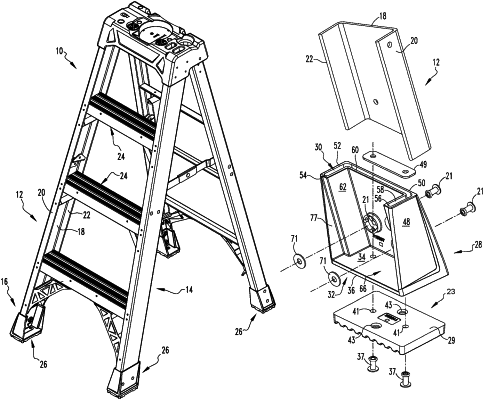| CPC E06C 7/46 (2013.01) [E06C 1/18 (2013.01); E06C 7/16 (2013.01)] | 5 Claims |

|
1. A ladder comprising:
a first rail having a web, a first flange attached to a first end of the web and a second flange attached to a second end of the web, the web having a front side and a rear side, and wherein portions of the web, the first flange, and the second flange form a bottom of the first rail;
a second rail, the front side of the web facing toward the second rail, the rear side of the web facing away from the second rail;
rungs attached to the first rail and second rail;
a foot having a body with a plurality of walls that extend from a base in one continuous piece to define a recess, the recess having an opening which receives the bottom of the first rail, wherein the base comprises a top side from which the plurality of walls extend and a lowermost planar surface that is opposite to the top side;
a metal rail fastener which extends through the body and the first rail to fixedly attach the body and the first rail together;
a pad having a rigid plate with an outer layer completely surrounding the rigid plate and a plurality of holes extending entirely through the rigid plate and outer layer, the outer layer of the pad having a bottom with treads and a flat uppermost surface, wherein the flat uppermost surface engages flush with the lowermost planar surface of the base when the pad is coupled to the base; and
a metal pad fastener that extends entirely through the pad by way of one of the plurality of holes and entirely through the base to attach the pad to the base so the rigid plate is between the treads and the base,
wherein the plurality of walls include a first wall, a second wall directly connected to the first wall, a third wall directly connected to the second wall, a fourth wall directly connected to the third wall, a fifth wall that directly connects to and extends essentially perpendicular from the first wall, a sixth wall that directly connects to and extends essentially perpendicular from the fifth wall and in parallel and in spaced relation with the first wall, a seventh wall that directly connects to and extends essentially perpendicular from the sixth wall and in parallel with and in spaced relation with the second wall, an eighth wall that directly connects to and extends essentially perpendicular from the fourth wall, and
wherein the recess is defined by the first through eighth walls to form a c-shaped cross-section.
|